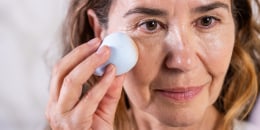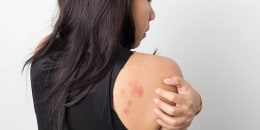If you hate using a thick, goopy sunscreen, then you're in luck. There's now a plethora of non-lotion SPF products including sprays, sticks and powders. But while it may be tempting to leave the sunscreen lotions behind for good, experts say you should take care to make sure you're using these newer formulas correctly.
Of those options, Dr. Nada Elbuluk tells TODAY.com she gets the most questions from her patients about spray sunscreens.
"If you are trying to do your full body and you're out on the beach or golf course, (using a sunscreen spray) feels like a fast way to get your sunscreen on without having to sit there and squeeze lotion out of a bottle and rub it and so forth," says Elbuluk, an associate professor of dermatology at the USC Keck School of Medicine.
Sunscreen sprays and sticks may be an attractive option for parents, too, whose kids don't enjoy the experience of putting on lotion sunscreen, she says. And people who wear makeup can find using SPF powder to be especially helpful — especially when it comes time to reapply.
But do sunscreen sprays, powders and sticks actually provide the same level of protection as a classic lotion? It all depends on whether or not you apply them correctly, experts say, and many of us probably aren't doing that.
How and when should I be wearing sunscreen?
We should all wear sunscreen on any exposed skin when we're outside, the American Academy of Dermatology recommends. And that sunscreen should have at least 30 SPF, be water resistant and protect against both UVA and UVB rays.
Facial sunscreen is an essential part of any daily skin-care routine, experts told TODAY.com previously.
There are two types of sunscreen, which are often referred to as mineral and chemical sunscreens. Children and people who are pregnant should stick to mineral sunscreens, which contain ingredients like titanium dioxide and zinc oxide, Elbuluk says, even if they're using a spray.
Are sprays, sticks and powders effective enough?
Although sunscreens are sold over the counter, they're still regulated in that they need to be made and tested according to specific guidelines from the Food and Drug Administration, Victoria Fu, cosmetic chemist and co-founder of Chemist Confessions, tells TODAY.com.
"All sunscreens are measured by weight per skin surface area," explains Gloria Lu, also a cosmetic chemist and co-founder at Chemist Confessions.
That means that all sunscreens — lotions, sprays, powders, sticks — are assessed in the same way: Evaluators apply 2 milligrams of the product per square centimeter to an area of participants' skin. "Then, they radiate the skin and measure how well (the sunscreen) protects skin against a certain dosage of UV light," Lu tells TODAY.com.
The issue is that, with some of these SPF formats, "because of the way it's dispensed or because of its density, people are less likely to get the marketed amount of protection," Lu explains.
As you can probably imagine, it's a lot harder to reliably get the recommended amount of a powder or spray than it is with a cream or lotion formula. It's especially challenging with powders because they weigh so much less than a lotion, meaning you'll need to use a lot more to get the same amount of protection than you would with a lotion.
"What people don't realize is that, for a powder, that's significantly more than what they imagine is just brushing it on," Fu says. "It's way more than people think — to the point where you actually have excess powder on the skin." (You can see a Chemist Confessions demonstration of just how much powder you would need here.)
But even for sprays and sticks, it can be tough for consumers to keep track of how much they need to apply.
"Typically, with the lotion, we say you're supposed to use about a shot glass's worth — or an ounce — for your whole body," Elbuluk explains. "But with the spray, it's really hard to know how much you've used." Experts recommend using enough spray so that your skin glistens.
And research shows that people already tend to apply way less than the recommended amount of lotion sunscreen.
If you're going to use a spray, stick or powder...
Elbuluk says her "first choice" for sunscreen is rubbing in a lotion or cream SPF. But "some sunscreen is better than no sunscreen at all," she says.
And there are some times when using a spray or stick can be really handy, like protecting a tattoo on your body or when you're out hiking and don't want to fuss around with a lotion. While the texture of a stick sunscreen can become unpleasant on the face if you're actually using enough, Lu says, it's often "less offensive" to apply the full recommended amount on your body.
And Elbuluk notes the mineral sunscreen powders are especially popular with her patients dealing with hyperpigmentation issues, who often need to reapply sunscreen throughout the day.
“People just need to be aware of the caveats of wearing enough, using it safely and using it effectively,” she says, “and knowing what to avoid as well.”
If a patient is set on using something like a spray, powder or stick, Elbuluk makes sure to talk to them about using that product in the most effective way possible.
- Don't forget to rub in spray sunscreen. After you spray the product onto your skin, you need to rub it in just like you would with a lotion, the experts emphasize. And consider using a different sunscreen on windy days when the product might blow away before getting to your skin.
- You'll need to use more than you think. It's really challenging to use enough sunscreen. For sticks, the AAD recommends making four full passes over your skin. Keep in mind that a standard 6-ounce bottle of spray sunscreen holds enough for six full-body uses, Elbuluk says. So if it's taking you longer than that to go through a bottle, you're probably not using enough.
- Hold the spray nozzle close to your skin. Holding the nozzle closer to your skin ensures that most of the product actually ends up on you — not in the air. To make sure you're using enough, "A good rule of thumb is to spray until your skin glistens," the AAD says.
- Try not to inhale spray sunscreen. Spray sunscreens contain ingredients that aren't meant to be inhaled and can be irritants, so use them with caution, Elbuluk says. Don't spray them directly into your face — spray into your hands first, she adds. Be mindful of those around you when spraying. "Anyone with underlying lung issues should not be using sprays at all," Elbuluk says.
- Save powders for reapplication. People who wear makeup may find it easier to reapply sunscreen over their products if it's a powder. But they should still use a classic lotion sunscreen as their first SPF, Elbuluk recommends. Meanwhile, Fu and Lu recommend most people steer clear of powder sunscreens altogether because it's so hard to use enough of them.
Finally, remember that sunscreen should just be one part of your sun protection plan. No matter what type of sunscreen you're using, it's important to use other sun-blocking tactics, too, the experts say.
That might include staying in the shade when possible, using UPF clothing that protects against UV rays, or tinting your car windows.
"Having some sort of physical barrier definitely helps a lot. Hats go a long way," Lu says. "We would say it's especially important for kids who absolutely don't like putting (sunscreen) on," Fu adds.
While cream and lotion sunscreens should remain your go-to in many situations, "there is a space" for sprays, sticks and powders, Elbuluk says, as long as you're using enough and you're applying it properly.










